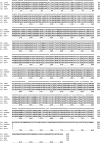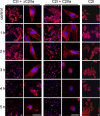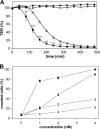Functional characterization of an extended binding component of the actin-ADP-ribosylating C2 toxin detected in Clostridium botulinum strain (C) 2300
- PMID: 20145093
- PMCID: PMC2849413
- DOI: 10.1128/IAI.01351-09
Functional characterization of an extended binding component of the actin-ADP-ribosylating C2 toxin detected in Clostridium botulinum strain (C) 2300
Abstract
Clostridium botulinum C2 toxin consists of the binding component C2II and the enzyme component C2I, which ADP-ribosylates G-actin of eukaryotic cells. Trypsin-activated C2II (C2IIa) forms heptamers that mediate cell binding and translocation of C2I from acidic endosomes into the cytosol of target cells. By genome sequencing of C. botulinum strain (C) 2300, we found that C2II from this strain carries a C-terminal extension of 129 amino acids, unlike its homologous counterparts from strains (C) 203U28, (C) 468, and (D) 1873. This extension shows a high similarity to the C-terminal receptor-binding domain of C2II and is presumably the result of a duplication of this domain. The C2II extension facilitates the binding to cell surface receptors, which leads to an increased intoxication efficiency compared to that of C2II proteins from other C. botulinum strains.
Figures






Similar articles
-
Channel formation by the binding component of Clostridium botulinum C2 toxin: glutamate 307 of C2II affects channel properties in vitro and pH-dependent C2I translocation in vivo.Biochemistry. 2003 May 13;42(18):5368-77. doi: 10.1021/bi034199e. Biochemistry. 2003. PMID: 12731878
-
Clostridium botulinum C2 toxin--new insights into the cellular up-take of the actin-ADP-ribosylating toxin.Int J Med Microbiol. 2004 Apr;293(7-8):557-64. doi: 10.1078/1438-4221-00305. Int J Med Microbiol. 2004. PMID: 15149031 Review.
-
The host cell chaperone Hsp90 is essential for translocation of the binary Clostridium botulinum C2 toxin into the cytosol.J Biol Chem. 2003 Aug 22;278(34):32266-74. doi: 10.1074/jbc.M303980200. Epub 2003 Jun 12. J Biol Chem. 2003. PMID: 12805360
-
Cellular uptake of Clostridium botulinum C2 toxin: membrane translocation of a fusion toxin requires unfolding of its dihydrofolate reductase domain.Biochemistry. 2003 Dec 30;42(51):15284-91. doi: 10.1021/bi0354278. Biochemistry. 2003. PMID: 14690438
-
New insights into the mode of action of the actin ADP-ribosylating virulence factors Salmonella enterica SpvB and Clostridium botulinum C2 toxin.Eur J Cell Biol. 2011 Nov;90(11):944-50. doi: 10.1016/j.ejcb.2010.11.007. Epub 2011 Jan 17. Eur J Cell Biol. 2011. PMID: 21247657 Review.
Cited by
-
Deciphering Molecular Virulence Mechanism of Mycobacterium tuberculosis Dop isopeptidase Based on Its Sequence-Structure-Function Linkage.Protein J. 2020 Feb;39(1):33-45. doi: 10.1007/s10930-019-09876-x. Protein J. 2020. PMID: 31760575
-
Clostridium difficile binary toxin CDT induces clustering of the lipolysis-stimulated lipoprotein receptor into lipid rafts.mBio. 2013 Apr 30;4(3):e00244-13. doi: 10.1128/mBio.00244-13. mBio. 2013. PMID: 23631918 Free PMC article.
-
Exploring the role of host cell chaperones/PPIases during cellular up-take of bacterial ADP-ribosylating toxins as basis for novel pharmacological strategies to protect mammalian cells against these virulence factors.Naunyn Schmiedebergs Arch Pharmacol. 2011 Mar;383(3):237-45. doi: 10.1007/s00210-010-0581-y. Epub 2010 Dec 1. Naunyn Schmiedebergs Arch Pharmacol. 2011. PMID: 21120455 Review.
-
Molecular Evolutionary Constraints that Determine the Avirulence State of Clostridium botulinum C2 Toxin.J Mol Evol. 2017 Apr;84(4):174-186. doi: 10.1007/s00239-017-9791-y. Epub 2017 Apr 5. J Mol Evol. 2017. PMID: 28382496
-
Hsp70 facilitates trans-membrane transport of bacterial ADP-ribosylating toxins into the cytosol of mammalian cells.Sci Rep. 2017 Jun 2;7(1):2724. doi: 10.1038/s41598-017-02882-y. Sci Rep. 2017. PMID: 28578412 Free PMC article.
References
-
- Barth, H., D. Blöcker, J. Behlke, W. Bergsma-Schutter, A. Brisson, R. Benz, and K. Aktories. 2000. Cellular uptake of Clostridium botulinum C2 toxin requires oligomerization and acidification. J. Biol. Chem. 275:18704-18711. - PubMed
-
- Barth, H., R. Roebling, M. Fritz, and K. Aktories. 2002. The binary Clostridium botulinum C2 toxin as a protein delivery system: identification of the minimal protein region necessary for interaction of toxin components. J. Biol. Chem. 277:5074-5081. - PubMed
-
- Binz, T., and A. Rummel. 2009. Cell entry strategy of clostridial neurotoxins. J. Neurochem. 109:1584-1595. - PubMed
-
- Blöcker, D., K. Pohlmann, G. Haug, C. Bachmeyer, R. Benz, K. Aktories, and H. Barth. 2003. Clostridium botulinum C2 toxin: low pH-induced pore formation is required for translocation of the enzyme component C2I into the cytosol of host cells. J. Biol. Chem. 278:37360-37367. - PubMed
Publication types
MeSH terms
Substances
Associated data
- Actions
LinkOut - more resources
Full Text Sources
Miscellaneous

